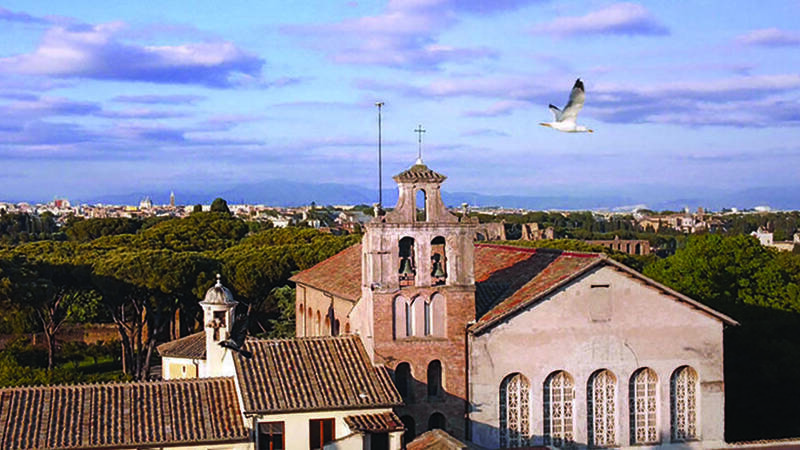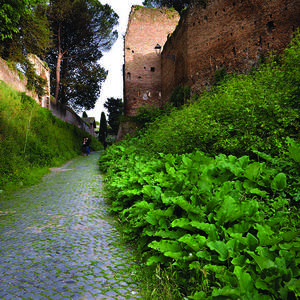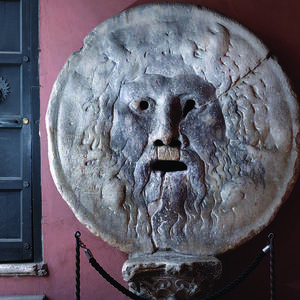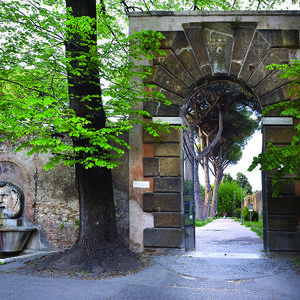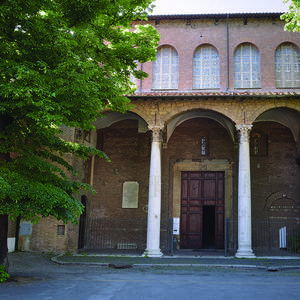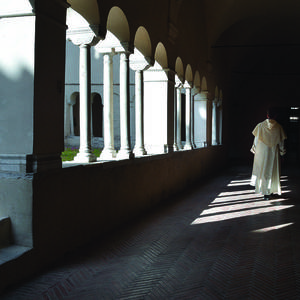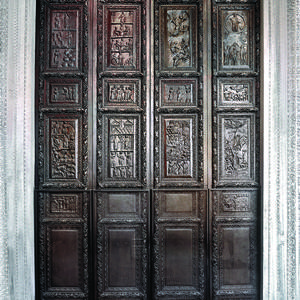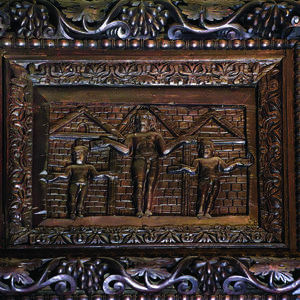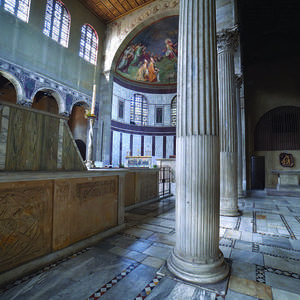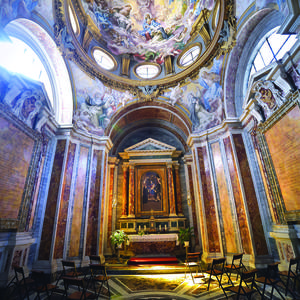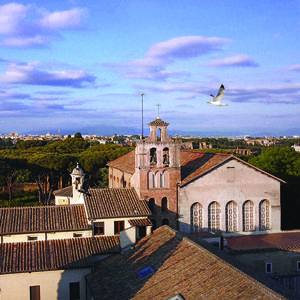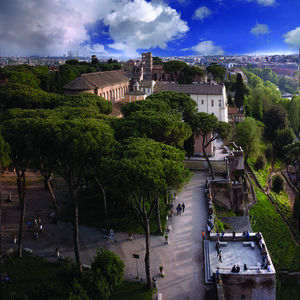In Rome one day in July, with no appointments till after the midday pause, I set out from Trastevere and walked over a bridge to the Aventine Hill.
The Aventino, as any guidebook will tell you, is one of the pleasantest places in Rome — a verdant refuge from the stony city. At the top of the hill is a piazza, and the brass keyhole of the Knights of Malta, which offers a framed view of the dome of St. Peter’s. There are churches, villas, an orange grove, and a parapet overlooking the tile roofs, cupolas and satellite dishes of Rome.
I dodged traffic, nodded obeisance to the Bocca della Verità — the “mouth of truth,” sheltered by a portico — and walked uphill along a mossed brick wall, a daypack on my back, in one hand a bag of biscotti I’d bought to take home to my wife and sons in Brooklyn.
The walk is a familiar one. Since 1998, I’ve gone to Rome about once a year — on reporting trips, for university events or with family, staying in an apartment an old friend opens to us — and the gaining of everyday familiarity with Rome has been a life-changing experience.
A few days here, a week there: Encountered this way, Rome is akin to a natural wonder. Its proverbial history of empire, fall, renaissance, sack, occupation, dolce vita and Euro-integration makes you feel that the forces of globalization and gentrification won’t prevail against it; and so it converts you to its outlook, which is gradual and additive. Every outing in Rome adds something — the osteria with two rickety tables that a colleague recommends; the African men awaiting day labor near the Porta Portese; the sight of the Caravaggios in San Luigi dei Francesi, which I’ve seen many times in light of the knowledge that Jorge Mario Bergoglio also saw them many times while lodging nearby.
That I’ve been to Rome before and will be here again supports such an outlook. Once, going to meet a friend at the tram on Via Arenula, I walked by Sant’Andrea della Valle — a church I pass daily when staying in the city’s historic center. That particular afternoon I went in. Sunlight was streaming in through high windows, banding the floor with diagonals. I stood there till the light subsided and then left, fulfilled, without reading a tag or taking a picture.
Rome is radiantly itself, staying in place as we change, and we trust that Rome will be Rome tomorrow and 10 years from now, shuttering at midday and then opening again.
Or will it? Italy was the first country in the West to be struck by COVID-19, which ravaged its elderly and its pilgrim-dependent economy, and the country went into a rigorous shutdown again earlier this year. Rome post-pandemic may not be there the way it has always been — and years may pass before Americans go there safely and in large numbers.
From Brooklyn, then, I go on pilgrimage to Rome imaginatively. I’ve got the Via Giulia on my screen saver, headlines from la Repubblica on my phone. And right here — tucked into a guidebook — are some postcards I bought on the Aventino, representing the sight I added to my encounter with the city that warm July day.
It’s 11 a.m. when I reach the top of the hill. A small private bus is disgorging passengers. I daub cold water onto my face from a fountain set into a brick wall — a bearded mythic visage with an open mouth — recalling the day our boys splashed here till their shirts were soaked.
The Basilica of Santa Sabina is set lengthwise along the crest of the hill, so as to face east. A simple doorway, human height, is cut into the high ornamental double doors. I go in.
It is empty. No people, no pews, just a mop in a pail on the tile floor — and, above and around, absurdly framing that mop and pail, a right rectangular prism: columns arched one to the next, windows set porthole-like into the rounded apse, and a paneled wood ceiling, like a giant, upside-down game board.
Time in Rome has taught me to try to see things whole. You don’t go straight to the painting or altar cited in the guidebook. The whole is the thing. Rome is the whole of wholes. And as you add to your experience of it, you deepen and complicate your sense of the whole.
Now, here again, I try to see the basilica whole. That I am alone stirs awe. How many people have congregated here — worshipped here, prayed, exchanged vows, huddled against pillage and plague and air raid — prior to my being here alone with a daypack and a bag of biscotti?
The maestro Daniel Barenboim comes to mind. Music, for him, is “shapely air” — and the act of music-making involves gathering musicians and audience in an apt setting and then shaping the air according to a composer’s intentions, for a here-and-now altering of time and space.
The empty basilica can be seen as shapely space: shaped by the ancient architect so that the light and air of this hill would intimate the divine.
In this space, I feel whole. I recognize myself as a Roman Catholic, shaped by the religion that has shaped this city, the way the space where I stand is shaped by the sacred architecture enclosing it — and I shudder a bit at the power of such shaping over us.
I kneel and pray inchoately. And then, a visitor after all, I fish in my pack for a guidebook.
Sabina was a saintly Roman matron, and the basilica was built near her home on the Aventino in the fifth century, the Church taking the site of a Roman temple through a kind of eminent domain.
In 1219 Santa Sabina was “given” to Dominic de Guzman as a base for the monastic order he was gathering around him, and there’s a cloister around the back where Dominicans have prayed and perambulated ever since. Not long after, Francesco di Bernardone, in Rome from Assisi, walked up the hill from Trastevere, and the two saints spent some time together here.
The interior was “disfigured” in the Baroque era by the architect Domenico Fontana, known for his work at St. Peter’s, and was restored to late-antique style a century ago. Today Santa Sabina is “perhaps the most beautiful basilica in Rome to have survived from the early Christian period.”
All this is in the Blue Guide, the sober historico-architectural guide to Rome. Interesting, but it doesn’t add to my sense of the whole. And that may be why a laconic comment catches my eye:
“In front of the church is a small 15th-century portico. In the vestibule on the left side of the church, the far door has 18 wooden panels carved with scriptural scenes, a remarkable survival from the early 5th century; they include one of the oldest representations of the Crucifixion in existence. . . .”
The oldest crucifixion: How can it be that it isn’t a showpiece, marked with a tag in four languages and a coin-activated spotlight? How can I not have seen it before?
I walk out of the church and stand in the portico, which is cool and shaded, and consider the double doors. Each is maybe 20 feet tall and 10 feet wide, and the far door is fronted by a wooden barrier, neither new nor old. The panels, poster-size, are carved into the dark wood.
I stand back and try to see the whole. What I see is a wedding — our wedding, on Mott Street in New York, 20 years ago, Lenora in white, family and friends coming out of the old cathedral there and onto the flagstones in front of its carved wooden doors; and then an Italian wedding, Romans in loose garments raising glasses of sparkling wine in front of these carved wooden doors.
In the shade, kept at a distance by the barrier, I can’t make out the individual panels. I take a camera out of my pack and zoom in on a few of them, but the framing and focus are off.
One of them is the oldest crucifixion scene in existence — but which one?
There’s a simple way to find out. Back in the basilica, I walk gingerly across the tile floor, as if crossing a frozen pond, and into a shop tucked off to one side. A young woman stands at the till, attentively doing nothing; she seems equipped for graduate work in Brussels, with late-model eyeglasses and an outsize smartphone.
“Cartoline?” I ask, and she points to several bins of postcards. I find the ones showing the doors: brown, on thick cardboard, printed long ago. A shepherd considers some sheep. A servant carries loaves of bread on a tray. Three figures face forward with outstretched arms. A robed man prods a stick into a bushel.
I deal the ancient images onto the bin, so as to get one of each. It’s a strangely familiar act. This is how I sorted baseball cards when I was a boy.
The woman tallies the cost, takes the cards and begins to wrap them in white paper. I want to say there’s no need for her to wrap them, but the Italian word that comes to mind — basta, enough — would sound brusque. I wait and watch until she is done.
The orange grove near Santa Sabina is as lively as the basilica was empty: children running in circles, an old man swatting at pigeons with a walking stick. I find a bench and unwrap the cards, shuffling them till I find the panel of three figures with outstretched arms.
I set it on my lap and try to see it whole: the crucifixion, before it was the Crucifixion. But I can’t focus. I’m in Rome, not Jerusalem, and it feels imperative to be here and not there.
Why is this? As I’ve said, my everyday experience of Rome is rooted in the sense that I’ve been here before and I’ll be here again. You might think that this sense would render another day in Rome just another day, but it has the opposite effect: When in Rome, seize the day.
This impulse has to do, I think, with the sense of wholeness I’ve gained from Rome. All of Rome is shapely space; the city is as patterned and sculpted and tinted and embellished by human artistry as any space on earth. It’s physical space that is also imaginative space. In Rome, I feel present — held, I want to say — within a larger whole, which I am loath to violate.
And it’s that feeling, I think, that leads me to the Aventino. This hill is as Roman as it gets: the basilica, the pines and cypresses, the gravel underfoot. And yet it is a refuge from Rome’s superabundance. Up here it’s possible to go outside Rome while being held within it — the mountains in a hazy distance and the tiled city below suggesting the whole that I am a part of.
I slip the cards into the guidebook. Golgotha can wait. Rome is all around.
The act of faith as an act of the imagination: This is an outlook that Rome, and Roman Catholicism, has shaped.
Here and now — Brooklyn, still subdued by the pandemic — that Crucifixion is a portal to Rome, not a distraction from it. The act of placing myself in Rome imaginatively is a crucial part of the pattern of Rome, and, in a similar way, of the crucifixion — and of Roman Catholicism.
I’m writing this essay in a space, six feet by six, formed by pine bookshelves in an L shape in a corner, and kitted out with a desk, stereo, guitar and some bric-a-brac — a painted postcard of the Villa Farnesina; a tiny chapel, built from Legos, sheltering a bearded ceramic pilgrim.
From here, I can see that the door panels of Santa Sabina are an anthology of key episodes in the salvation narrative — a narrative that was being shaped when the panels were carved. The cards offer close-ups. I shine a light on them forensically. The panels are dense with activity. Some combine several episodes, so that the Israelites approach the Red Sea, their horses contort in the waves and Moses summons the serpent in the same panel. The carving is likewise precise. The water Moses has brought forth from the rock is a gusher; the loaves Jesus just multiplied are fluffy and freshly scored on their tops.
I shuffle the cards into chronological order, a speed-test of biblical knowledge. The calling of Moses comes before the miracle of the serpent, obviously. The assumption of Elijah must precede the carrying-off of Habakkuk, but I don’t know the latter story, so I find it in the blue Jerusalem Bible I got after college — the Lord commanding Habakkuk to take provisions to Daniel in the lion’s den and the angel carrying him there by the hair of his head.
The Crucifixion winds up in the middle of the deck, followed by panels showing the appearances of Jesus alle pia donne (to the pious women), to the disciples at Emmaus and in the “Supper Room”; the Ascension; and the Triumph of Christ and the Church — topped by a cross.
The crucifixion panel is simpler than the others, stark and bluntly carved. I try to see it whole.
Jesus and the two thieves face front and center with their arms outspread. Each is in his own space (a booth, I want to call it) with a brick wall and a pointed roof. Jesus is a third larger than the others. He is unclothed, his waist wrapped with a narrow cloth (a thong, I want to call it). He is ruggedly manly: heavy legs, etched abdominal muscles, scraggly hair and beard. The two thieves look infantile by contrast, all round cheeks and soft shoulders.
At a glance, you wouldn’t know for sure that it is a crucifixion. The three figures appear to be standing. There are no crosses, no trees, no skulls, no stony ground. But there are the heads of the nails driven through the hands of Christ and the two thieves, details that affix the scene to the scriptural episode as firmly as the nails themselves held those figures to their crosses.
Why is this Crucifixion so simple, in a set of panels so intricately carved?
Maybe because it is so early. We typically think of “early” as a pure state, close to the point of origin. Those fifth-century carvers, working in a city that was a lively early center of Christianity probably knew specifics of the crucifixion story that are lost to us or that have been obscured by embellishment.
By that way of thinking, Christian art should be richly detailed in the beginning and grow starker with time. But things didn’t go that way; Christian art got more complex, fantastically so, through a process (medieval, Renaissance, Mannerist, Baroque, rococo) that Rome represents in concentrated form.
I try to imagine how many crucifixion scenes there are in Rome. I cannot. Truly, they are past numbering. And yet here in Brooklyn I can’t bring a particular one to mind. The mosaics in Santa Maria in Trastevere show Christ and the Virgin enthroned. The Sistine Chapel envisions the Last Judgment. Caravaggio painted John beheaded, Matthew called, Paul converted, Peter crucified upside down.
In Rome, the crucifixion is present but not prominent. On one level, this seems to bear out the Reformation allegation that the Papists took their eyes off the prize. On another, however — and the insight quickens as I shuffle through the cards again — it suggests that the religious art of Rome has developed along the pattern set out in the fifth century at Santa Sabina.
In Rome, as on those doors, the crucifixion is one episode of many, and yet it is distinctly unlike the others. Those other episodes called forth embellishment, prompted the artists to fill them in imaginatively; with the crucifixion, the imaginative act has been left largely to us.
The act of faith as an act of the imagination: This is an outlook that Rome, and Roman Catholicism, has shaped. Ever since Peter was crucified at a bend in the river, Rome has been a destination for pilgrims — and also for artists, who come to Rome, pilgrims themselves, to make art for the pilgrim trade. The city is an anthology of ways artists have imagined salvation history from one era to the next, the images multiplied like loaves and fishes. As they imagine, they invite the pilgrim in Rome, the believer or would-be believer, to do likewise. All those entries into Jerusalem, agonies in the garden and dividings of garments; all those depositions and piètas — they place us in the scene and suggest ways for us to see it ourselves.
In the process, they suggest ways for us to see the Crucifixion — to place ourselves in the scene of the central episode that, now as then, is something like unimaginable.
And they invite us to keep on seeing after we have left Rome. The history of pilgrimage that has shaped Rome is what makes it an open city. All the coming and going has worn down the anxiety-inducing distinctions between the city of tourists and the “real” city. And the act of pilgrimage, however informal, is completed by the journey home. Returning home, we bring the holy city with us — in images, memories, devotions. From here we go there imaginatively.
For some of us the patterns of Rome, shapely city par excellence, become patterns of heart and soul. So St. John Henry Newman, who traveled to Rome in 1832, was moved to write his great devotional poem “Lead, Kindly Light” on the journey home. So Thomas Merton, drafting an autobiography in Kentucky, gave a run of pages to recalling his time in Rome in his teens: “how I climbed the deserted Aventine, in the spring sun, with my soul broken up with contrition, but broken and clean,” and how, in Santa Sabina, he knelt and prayed in a church for the first time in his life.
The act of pondering those images from afar, as I am doing here and now in Brooklyn, joins us to the long history of pilgrimage to Rome. So does the act of pondering Rome as a whole.
Sure, all this is true, to some extent, of travel generally — the scarf or scrapbook or vase in the corner reminding us of places we’ve gone. It’s true for other places we call holy — the church where we were married, the abbey where silence felt like a means of survival. And it’s true, I suspect, for people of other faiths, or of no faith at all, thriving on Rome’s many points of entry into the salvation narrative it has shaped. What’s distinctively Roman is that in Rome the pattern of pilgrimage is out in the open, built into the city rather than projected onto it.
The way of life we’ve adopted since the coronavirus reached us has brought this pattern further out into the open. The pandemic’s effects have been grave: several million deaths, untold job losses, long habits of human gathering interrupted and altered. For many of us, the most basic everyday effect of the pandemic has been its way of fixing us in place for a year or more.
Staying in place has made us inadvertent anchorites; and it has returned us to the age before cruise ships and jet planes, when distant places were to be visited rarely, not regularly.
Not so long ago, I felt like a glutton for Rome; now the days I have spent there stand as superabundance, experiences stored up to be understood retrospectively and imaginatively.
And so, pilgrim-like, I go to Rome again. At my desk in Brooklyn I am on a bench on the Aventino, watching our sons, 8 and 8 and 5, stick tulips on their fingertips like talons, with the scent of ripe oranges in the air and the basilica behind. They are teenagers now. If — the thought comes unbidden — I asked them, as a last wish, to go to the Aventino someday and bend a knee in the basilica and splash water on their faces, they would know what to do and what it meant. And if at the hour of my death I were to picture that carved Crucifixion, it would come to mind clear and whole, the figure at the center made vivid by lack of embellishment.
I go to the parapet. The view is hazy with midday heat. I look out: How strange it is that those roofs and campaniles belong to the part of Rome that, after 20 visits, I think of as my part. And then I walk down the hill via the footpath, hoping I am not too late to get a place at one of those rickety tables.
Paul Elie is a senior fellow in Georgetown University’s Berkley Center for Religion, Peace, and World Affairs and a regular contributor to The New Yorker. He is the author of The Life You Save May Be Your Own and Reinventing Bach.
